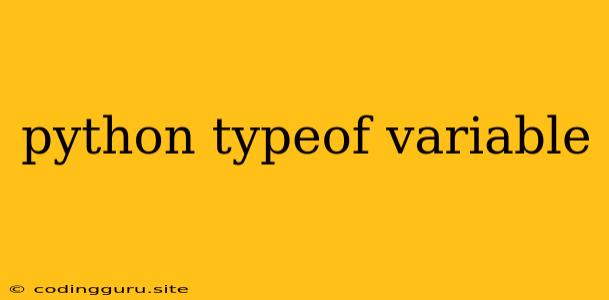In the realm of programming, Python, known for its readability and ease of use, often invites questions about the nature of variables. One such question frequently arises: How do we determine the type of a variable in Python? This article delves into the intricacies of variable types in Python and explores the various methods to uncover their underlying nature.
Unveiling the Essence of type()
The type() function serves as the cornerstone for determining the type of a variable in Python. It takes a single argument, the variable in question, and returns its type. Let's illustrate this with a simple example:
my_variable = 10
print(type(my_variable)) # Output:
In this example, we assign the integer value 10 to the variable my_variable. Calling type(my_variable) reveals that its type is <class 'int'>, indicating that it holds an integer value.
Exploring the Diverse Landscape of Python Data Types
Python embraces a rich array of data types, each with its unique characteristics. Let's delve into some of the most common data types:
-
Integers (int): These represent whole numbers, both positive and negative.
-
Floats (float): Represent numbers with decimal points.
-
Strings (str): Sequences of characters, enclosed in single or double quotes.
-
Booleans (bool): Represent truth values, either
TrueorFalse. -
Lists (list): Ordered collections of elements, enclosed in square brackets
[]. -
Tuples (tuple): Similar to lists, but immutable, enclosed in parentheses
(). -
Dictionaries (dict): Unordered collections of key-value pairs, enclosed in curly braces
{}.
Beyond type(): The Power of isinstance()
While type() provides a straightforward way to determine the type of a variable, it can sometimes be limiting. For instance, let's say you have a variable that could be either an integer or a float. type() would only return int or float respectively.
Here's where isinstance() comes into play. It allows you to check if a variable is an instance of a specific class or any of its subclasses. This offers greater flexibility:
my_variable = 10
print(isinstance(my_variable, int)) # Output: True
print(isinstance(my_variable, float)) # Output: False
my_variable = 10.5
print(isinstance(my_variable, int)) # Output: False
print(isinstance(my_variable, float)) # Output: True
In the first snippet, isinstance(my_variable, int) returns True because my_variable is an instance of the integer class. However, isinstance(my_variable, float) returns False as my_variable is not an instance of the float class.
In the second snippet, the roles are reversed, with isinstance(my_variable, float) returning True and isinstance(my_variable, int) returning False.
Practical Applications of Determining Variable Types
Understanding the type of a variable is crucial for various aspects of Python programming:
-
Conditional Statements: Determining the appropriate course of action based on a variable's type.
-
Data Manipulation: Applying specific operations based on the type of data being processed.
-
Function Definitions: Enforcing type constraints for function parameters and return values.
-
Error Handling: Identifying potential type-related errors and handling them gracefully.
Conclusion
Determining the type of a variable in Python is a fundamental skill for any programmer. By utilizing the type() function, you can gain insight into the underlying nature of your variables. For more nuanced checks, the isinstance() function offers a valuable tool for ensuring compatibility and handling inheritance. As you delve deeper into Python programming, understanding how to identify and work with different variable types will prove to be an invaluable asset.
